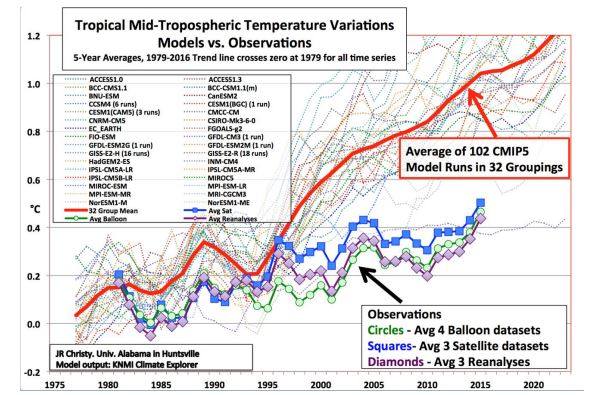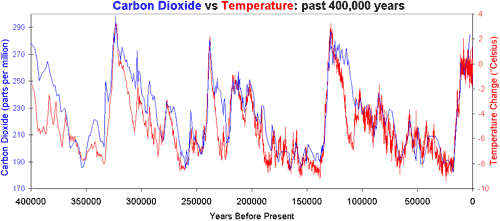
Vostok ice core records for carbon dioxide concentration and temperature change
See Eric Monnin et al, Atmospheric CO2 Concentrations over the Last Glacial Termination Science 291, 112 (2001) and https://courses.seas.harvard.edu/climate/eli/Courses/global-change-debates/Sources/Temperature-leads-CO2-in-ice-cores/more/Monnin-2001.pdf
During the last 600 million years, temperature and CO2 have been essentially unrelated.
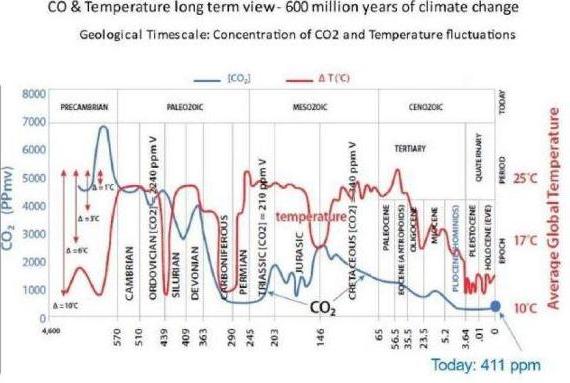
Dr. C. R. Scotese, Analysis of the Temperature Oscillations in Geological
Eras (2002)
W. F. Reddman, Earth's Climate: Past and Future W. H. Freeman and Sons
(2001)
Mark Pagini et al, Marked Decline in Atmospheric Carbon Dioxide
Concentrations During the Paleocene, Science 309, 5734, pp 600-603
(22 July 2005) [Ordovician period corrected 7 July 2008]
Robert A. Berner, Reconstructed Atmospheric Carbon Dioxide
Concentrations (2001)
C. R. Scotese, H. Song, B. J. W. Mills, and D. G. Van der Meer, Phanerozoic
paleotemperatures: The Earth's changing climate during the last 540 million
years, Earth-Science Reviews 215, 103503 (2021)
https://doi.org/10.1016/j.earscirev.2021.103503 and
Global Mean Surface
Temperatures for 100 Phanerozoic Time Intervals
More complete discussion at Professors Challenge the Canard of Anthropogenic Climate Change
These cycles are also evident in the historical record, going back to the pre-Roman Egyptian cooling, the Roman warning, the Dark Ages, the Medieval warming, and the Little Ice Age, from which we are just now emerging. People didn't write “gee, the climate is cooling” (or warming) but Egyptians wrote about needing to build dams and canals, Romans noted that grapes were growing in Britain, Slavs moving up the Eastern Alps thought the Germans had abandoned the land because they got fat and lazy — and then they had to abandon the same land when the glaciers returned, ….
The cycles appeared in the 1995 IPCC report, but were removed in the 2001 report, at the insistence of the editor, Michael Mann, to preserve the illusion of reality of his infamous “Hockey Stick” graph.

The last 1000 years of Earth Temperatures from Tree Rings, Ice Cores, and Thermometers
Figure 22 in IPCC's Climate Change 1995
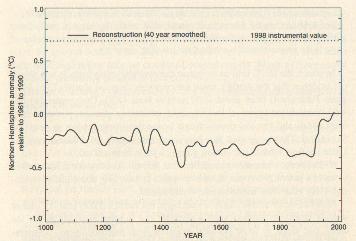
Infamous “Hockey Stick” Graph that Eliminates the Dark
Ages, the Medieval Warming, and the Little Ice Age
Figure 2.20 in IPCC's Climate Change 2001
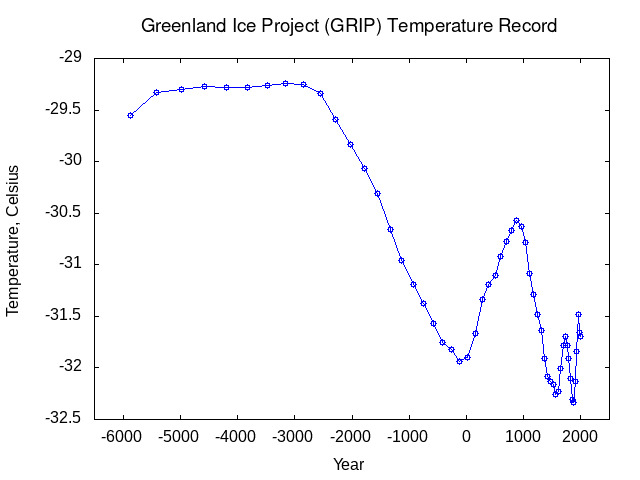
From https://www.iceandclimate.nbi.ku.dk/data/ddjtemp.txt:
In Greenland:
The warmth of the climatic optimum during the European stone age 5000 years ago is clearly seen, just as the cool period during the Roman age and the relative warmth of the Viking age (where the Norsemen settled in Iceland and Greenland) and the two cold periods of the "little ice age" at 1600 AD and 1875 AD. The warming in Greenland in the 20th century only lasts until 1950 AD. After that it has become colder.
Fossil fuels have been underground, not exposed to cosmic rays, for millions of years. They therefore do not contain any carbon-14: Burning fossil fuels dilutes the atmospheric concentration of carbon 14 in CO2.
If emissions of CO2 caused by burning fossil fuels were the only source for the observed decrease in the concentration of carbon-14 in CO2 in the atmoshphere since 1750, and therefore the only source of increase of the total concentration of CO2 in the atmosphere, the trend of its dilution, as measured in stalactites, ice cores, lake bed and ocean bottom sediments, bogs, …, would be much more than observed.
Kenneth Skrable, George Chabot, and Clayton French analyzed this in World Atmospheric CO2, Its 14C Specific Activity, Non-fossil Component, Anthropogenic Fossil Component, and Emissions (1750-2018), which appeared in Health Physics 122, 2, pp 291-305 (1 February 2022), doi: https://doi.org/10.1097/HP.0000000000001485. From the abstract:
After 1750 and the onset of the industrial revolution, the anthropogenic fossil component and the non-fossil component in the total atmospheric CO2 concentration, C(t), began to increase. Despite the lack of knowledge of these two components, claims that all or most of the increase in C(t) since 1800 has been due to the anthropogenic fossil component have continued since they began in 1960 with the "Keeling Curve: Increase in CO2 from burning fossil fuel." Data and plots of annual anthropogenic fossil CO2 emissions and concentrations, C(t), published by the Energy Information Administration, are expanded in this paper. Additions include annual mean values in 1750 through 2018 of the 14C specific activity, concentrations of the two components, and their changes from values in 1750. The specific activity of 14C in the atmosphere gets reduced by a dilution effect when fossil CO2, which is devoid of 14C, enters the atmosphere. We have used the results of this effect to quantify the two components. All results covering the period from 1750 through 2018 are listed in a table and plotted in figures. These results negate claims that the increase in C(t) since 1800 has been dominated by the increase of the anthropogenic fossil component [my emphasis]. We determined that in 2018, atmospheric anthropogenic fossil CO2 represented 23% of the total emissions since 1750 with the remaining 77% in the exchange reservoirs. Our results show that the percentage of the total CO2 due to the use of fossil fuels from 1750 to 2018 increased from 0% in 1750 to 12% in 2018, much too low to be the cause of global warming.

Each DOUBLING of CO2 concentration ADDS 0.84 degrees Celsius to the average Earth surface temperature, not the 3 degrees the IPCC uses to scare us. Read that again: A DOUBLING, not an increment from 400 to 500 ppmv.
From our calculation, a doubling of CO2, produces a tropospheric [lower atmosphere] temperature change of 0.8°K. However, as more CO2 is added to the atmosphere, the rate of temperature increase is proportionally less and less, and the increase eventually levels off. Even for an increase in CO2 by a factor of 10, the temperature increase does not exceed 2.5°K.Therefore, the runaway greenhouse effect does not occur because the 15-μm CO2 band, which is the main source of absorption, 'saturates,' and the addition of more CO2 does not substantially increase the infrared opacity of the atmosphere.
They wrote this at the time when "scientists" were worrying about the coming ice age. Their conclusion is "we can't prevent the ice age by burning fossil fuels."
What does "saturate" mean? Imagine you have a greenhouse in which visible light passes through the glass roof, strikes materials inside and warms them. Then some of that heat is re-radiated as infrared light. Your greenhouse warms because the glass does not transmit infrared light as well as visible light. In other words, it holds heat inside. Suppose it retains 90% of the infrared light. If you add another sheet of glass, your greenhouse does not retain 180% of the re-radiated infrared light. That would be absurd. Instead, the second sheet reflects or absorbs 90% of the 10% that got through the first sheet. A third sheet would reflect or absorb 90% of the 1% that got through the first three sheets....
